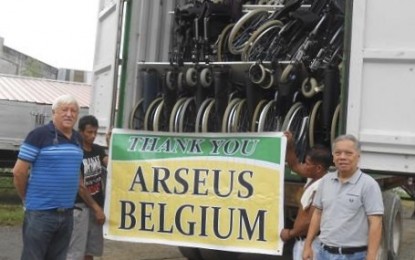
WATER SHORTAGE. Roberto Varquez, chair of the newly-formed Cebu City Water Advisory Committee, poses with Belgian Patrick Haghedooren in front of a donated container of hospital equipment. Varquez said the committee is now looking for immediate solutions to water shortage experienced by more than 20 villages in Cebu City. (Photo from the Facebook page of Patrick Haghedooren)
CEBU CITY – The head of the advisory committee formed to address water shortage in this city on Tuesday said they are now scouting for alternative solutions to the water crisis.
Roberto “Bu” Varquez, chair of the Cebu City Water Advisory Committee, said the current shortage of water supply affecting more than 20 villages here needs alternative solutions that can be implemented while the city authorities are looking for long-term solutions.
“Based on our research, there are a lot of factors that we can consider why the people are grueling on the water supply problem,” Varquez, an investment and systems analyst expert, told the Philippine News Agency (PNA) in a phone interview.
The advisory committee was formed by Mayor Edgardo Labella on Monday through an executive order to address the shortage of water that hit many villages here.
In the survey in the city hilly areas, Varquez said he discovered “small things” considered to be an alternative system in addressing the lack of water for the crops, which, he claimed, the farmers failed to adopt.
“The most effective way to water the plants is drip water irrigation system. Many vegetable plants in the hilly lands don’t need splash type of irrigation. Drip water irrigation is one of the things that they don’t practice because they don’t know about it,” Varquez said.
He also said the city residents should learn about the principle of “virtual water” or “water that we eat” which represents thousands of liters of water needed to grow the plant or animal before they can be harvested for human consumption.
He said chocolate needs 17,000 liters from planting, growing up to harvesting, while beef needs 15,000 liters of water from farrowing to slaughter for consumption.
“These are small things that we ought to know. The city should make a massive information campaign on everything that we consume. We can avoid crops and animals that need a lot of water for production,” Vaquez said.
Varquez said the city can also require building permit applicants to install rainwater catchment facility as mandated by the National Building Code.
He said there are many government multi-purpose gyms and buildings which have no rainwater catchment facility.
“If the city can direct multi-purpose buildings in the barangays to set up rainwater catchment, we can start penalizing buildings that do not follow the Building Code,” he said.
Labella said the city government will coordinate with the Local Water Utilities Administration in evaluating the failure of the Metro Cebu Water District board to perk up programs that would address the water problem in the metropolitan area. (PNA)
